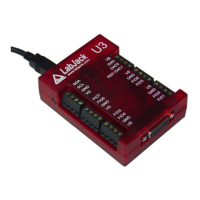Outputs:
•
4.2.3 eG (
and ePut functions do AddRequest, Go, and GetResult, in one step.
The eGet vers ving parameters as they take a pointer to a
double wh esired
value. Thi input and output (number
of scans re
he ePut versions are designed for outputs or setting configuration parameters and will not
return anything except the error code.
stants in languages that cannot
ngs
”
double
d thus is an input only.
Declaration:
pHandle – A pointer to a handle for a LabJack.
et ) and ePut()
The eGet
ions are designed for inputs or retrie
ere the result is placed, but can be used for outputs if pValue is preset to the d
s is also useful for things like StreamRead where a value is
quested and number of scans returned).
T
eGetS() and ePutS() are special versions of these functions where IOType is a string rather
than a long. This is useful for passing string constants in languages that cannot include the
header file, and is generally used with all IOTypes except put/get config. The string should
contain the constant name as indicated in the header file (such as “LJ_ioANALOG_INPUT”).
The declarations for the S versions are the same as the normal versions except for (…, const
char *pIOType, …).
eGetSS() and ePutSS() are special versions of these functions where IOType and Channel are
trings rather than longs. This is useful for passing string con
s
include the header file, and is generally only used with the put/get config IOTypes. The stri
should contain the constant name as indicated in the header file (such as “LJ_ioPUT_CONFIG
and “LJ_chLOCALID”). The declaration for the SS versions are the same as the normal
versions except for (…, const char *pIOType, const char *pChannel, …).
he declaration for ePut is the same as eGet except that Value is not a pointer (…,T
Value, …), an
LJ_ERROR _stdcall eGet ( LJ_HA
long IO
long Ch
double *pValue,
long x1)
ter
NDLE Handle,
Type,
annel,
Parame
Description:
LabJack errorcodes or 0 for no error.
Returns:
Inputs:
•
Outputs:
•
• Handle – Handle returned by OpenLabJack().
• IOType – The type of request. See Section 4.3.
• Channel – The channel number of the particular IOType.
pValue – Pointer to Value sends and receives data.
• x1 – Optional parameter used by some IOTypes.
pValue – Pointer to Value sends and receives data.
50

